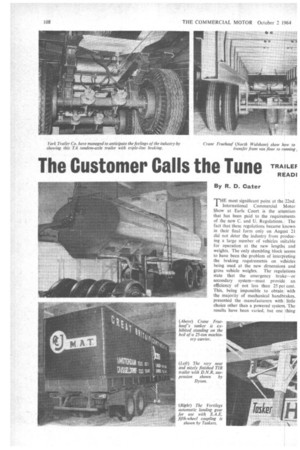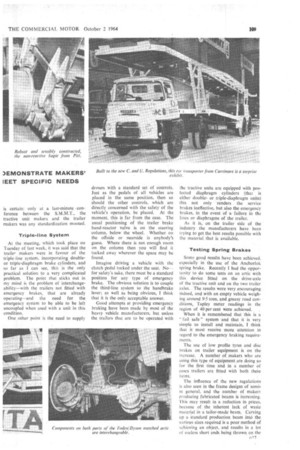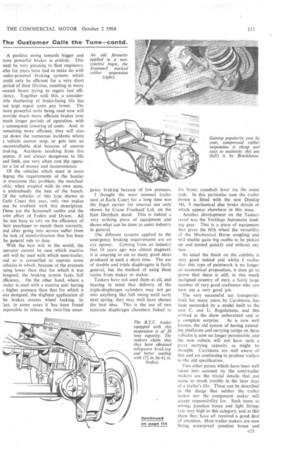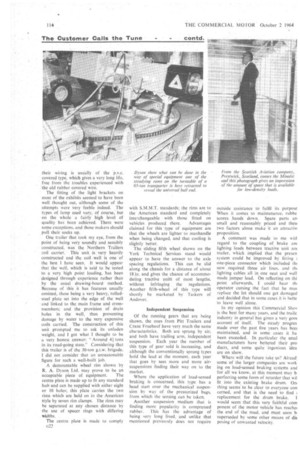The Customer Calls the Tune TR: E ll- A ; DEMONSTRATE MAKERS' IEET SPECIFIC
Page 110

Page 111

Page 112

Page 115

Page 116

If you've noticed an error in this article please click here to report it so we can fix it.
NEEDS By R. D. Cater THE most significant point at the 22nd. International Commercial Motor Show at Earls Court is the attention that has been paid to the requirements of the new C. and U. Regulations. The fact that these regulations became known in their final form only on August 21 did not deter the industry from producing a large number of vehicles suitable for operation at the new lengths and weights. The only stumbling block seems to have been the problem of interpreting the braking requirements on vehicles being used at the new dimensions and gross vehicle weights. The regulations state that the emergency brake—or secondary system—must provide an efficiency of not less than 25 per cent. This, being impossible to obtain with the majority of mechanical handbrakes, presented the manufacturers with little choice other than a powered system. The results have been varied, but one thing
is certain: only at a last-minute–eortference between the S.M.M.T., the tractive unit makers and the trailer makers was any standardization mooted.
Triple-line System
At the meeting, which took place on Tuesday of last week, it was said that the trailer makers were in favour of the triple-line system, incorporating doubleor triple-diaphragm brake cylinders, and so far as I can see, this is the only practical solution to a very complicated problem. The point that slicks out in my mind is the problem of interchangeability—with the trailers not fitted with emergency brakes, that are already operating—and the need for the emergency system to be able to be left uncoupled when used with a unit in this condition.
One other point is the need to supply
drivers with a standard set of controls. Just as the pedals of all vehicles are placed in the same position, then so should the other controls, which are directly concerned with the safety of the vehicle's operation, be placed. At the moment, this is far from the case. The usual positioning of the trailer brake hand-reactor valve is on the steering column, below the wheel. Whether on the offside or nearside is anybody's guess. Where there is not enough room on the column then you will find it tucked away wherever the space may be found,
Imagine driving a vehicle with the clutch pedal tucked under the seat. No— for safety's sake, there must be a standard position for any, type of emergency brake._ The obvious solution is to couple the third-line system to the handbrake lever; as well as being obvious, I think that it is the only acceptable answer.
Good attempts at providing emergency braking have been made by most of the heavy vehicle manufacturers, but unless the trailers that are to be operated with
the tractive units are equipped with protected diaphragm cylinders (that is either doubleor triple-diaphragm units) this not only renders the service brakes ineffective, but also the emergeney brakes, in the event of a failure in the lines or diaphragms of the trailer.
As it is, on the trailer side of the industry the manufacturers have been trying to get the best results possible with the material that is available.
Testing Spring Brakes
Some good results have been achieved, especially in the use of the Anchorlok spring brake. Recently I had the opportunity to do some tests on an artic with this device fitted on the drive-axle of the tractive unit and on the two trailer axles. The results were very encouraging indeed, and with an empty vehicle weighing around 9.5 tons, and greasy road conditions, Tapley meter readings in the region of 40 per cent were achieved. . When it is remembered that this is a " fail safe" system and that it is very simple to install and maintain, I think that it must receive more attention in regard to the emergency braking require. ments.
The use of low profile tyres and disc brakes on trailer equipment is on the increase. A number of makers who are using this type of equipment are doing so for the first time and in a number of cases trailers are fitted with both thee items.
The influence of the new regulations is also seen in the frame designs of semis in general, and the number of makers producing fabricated beams is increasing. This may result in a reduction in prices, because of the inherent lack of waste material in a tailor-made beam. Carving up a Standard production beam into the various sizes required is a poor method of tchieving an object, and results in a lot of useless short ends being thrown on the
scrapheap; and, of course, these must be paid for by someone.
The entrance of Crane Fruehauf Trailers into the tanker production field has been one of the surprises of the Show, and although the show tanker is built in high-tensile steel, very shortly the company intends to produce custom-built units in stainless steel. This is good news for the prospective purchaser for generalpurpose work, who cannot—just yet, at any rate—rely on any other material to do his work satisfactorily.
The emergency braking that for some time has been the standard equipment on fifth-wheel coupled, air-braked trailers is now available on trailers fitted with the Hands Autosafe automatic coupling. This is a completely universal unit which will match any auto-coupling produced over the years, and it is fitted With a springloaded braking system that comes into operation as soon as the hitch is released. It is claimed that a minimum of 0.25g braking force is produced by this equipment, even in its worst state of adjustment. Other features of the coupling are that it will not collapse beyond a certain level if dropped awkwardly, and it can be picked up by the tractive unit, irrespective of the landed condition, without the need for garage equipment.
Certain applications need special vehicles, and in this field the trailer.manufacturer .excels himself, The transporter on the Dyson stand proved this beyond any doubt, but was by no means the only special built. In fact, almost every maker has to build something special each year, and it is not always the largest companies that turn out the most specials; some of the smaller firms exist on building one-offs which create various difficulties in design and development.
Continental operation has demanded a lot of progress in the design of the TIR trailer. The latest development is the use of the roofless-van type of vehicle, and the one on the York stand showed very clearly what can be done in this field. Dispensing with the unwieldy tilt frame assembly hitherto used in conjunction with the standard TER, the Envoy, as it is called, makes crane loading a much more feasible operation and subsequent covering and sealing much more effective.
Low-loader problems Low loaders have always been specialist vehicles which spend much of their operating time loading and unloading. Many efforts to cut down the time involved in dismantling the rear axle assembly—to say nothing of the hard labour required, usually under anything but ideal conditions—have been made. Two makers have evolved ground-level loaders which go some way towards filling the gap, and they showed the results at Earls Court Tor the first time this year. One is called the Forelode, made by Charles Pitt (Barton Stacey) Ltd. The other is a design by D. H. Morgan (Engineering) Ltd., built by Taskers of Andover, and called the Hydrocouple. Both these trailers go a long way towards solving the low-loader problem and further development is likely. Other companies make automatic ground-level loaders but these were not exhibited at this year's Show.
The non-reactive suspension units shown by a number of makers, all having their own built-in characteristics, are making a contribution to the. improvement of trailerization by way of better handling, better braking and less need of maintenance: This last point is not only related to the running gear, but also in the extra life given to the bodywork of the outfit concerned. The number of semis that have prematurely shaken apart in the past (this being aggravated in no small way by excessive axle-hop when braking) must be high, to say the least. I can remember one particular make, which shall remain nameless, in which with monotonous regularity the spring hanger brackets were poked through the tank to which it was mounted, simply because of this.
The life of the tyre equipment on this type of bogie is also increased, and as this is the third most expensive item in running costs---next to wages and fuel— it cannot be ignored. A positive swing towards bigger and nore .powerful brakes is evident. This mist be very pleasing to fleet engineers, who for years have had to make do with alder-powered braking systems which r.'.ouIcl only be efficient for a very short period of their lifetime, resulting in many wasted hours trying to regain lost effiiency. Together with this, a considerAble shortening of brake-lining life has root kept repair .costs any lower. The more powerful units being used now will provide much more efficient brakes over much longer periods of operation, with a consequent lowering of costs. And, in remaining more efficient, they will alsout down the numerous incidents where
A vehicle cannot stop, or gets into an ancontrollable skid because of uneven braking. Accidents resulting from this source, if not always dangerous to life gid limb, can very often cost the operator aflot of money and inconvenience.
Of the vehicles which meet in some degree the requirements of the haulier :o overcome this problem, the matchedartic, when coupled with its own mate, is undoubtedly the best of the bunch. C:ofthe vehicles of this type shown at Earls Court this year, only two makes can be credited with this description. Mese are the Scamrnell outfits and the loint effort of Foden and Dyson. All he rest have to rely on the efficiency of .heir purchaser to match them correctly, ind after going into service suffer from .he lack of standardization that has been he general rule to date. .
With the best will in the world, the verator cannot be sure which tractive mit will be used with which semi-trailer, ind so is compelled to operate some iehicles in which, because of the pressure ving lower than that for which it was lesignecl, the braking system lacks full :fficiency. On the other hand, where a sailer is used with a tractive unit having higher pressure than that for which it was designed, the slightest application of he brakes creates wheel . locking. In 'act, in some cases it has been found mpossible to release the twin-line erner geney braking because of low pressure.
I thought the most unusual trailer seen at Earls Court for a long time was the Ingot carrier for internal use only shown by Crane Fruehauf Ltd. on the East Dereham stand. This is indeed a very striking piece of equipment and shows what can be done to assist industry in general.
The different systems applied to the emergency braking requirements are an eye opener. Coming from an industry that 10 years ago was almost stagnant, it is amazing to see so many good ideas produced in such a short time. The use of double and triple diaphragms is fairly general, but the method of using them varies from maker to maker.
Taskers have not-used them at all, and bearing in mind that delivery of the triple-diaphragm cylinders may not get into anything like full swing until early next spring, they may well have chosen the best idea. This is the use of two separate diaphragm chambers linked to the brake camshaft lever via the usual rods. In this particular case the trailer shown is fitted with the new Dunlop Mk. 9 mechanical disc brake details of which appear elsewhere in this issue.
Another development on the Taskers stand was the Vertilegs Automatic landing gear. This is a, piece of equipment that gives the fifth wheel the versatility of the Mechanical Horse coupling and will enable quite. big outfits to be picked up and landed quickly and without any fuss.
As usual the finish on the exhibits is very good indeed and whilst I realise that this type of paintwork is no longer an economical proposition, it does go to prove that there is still, in this much maligned country of ours, a fairly large number of very good craftsmen who can turn out a very good job.
The very successful car transporter, built for many years by Carrimore, has been succeeded by a model built to the new C. and U. Regulations, and this arrived at the show unheralded and as a complete surprise. As is now well known, the old system of having extending platforms and carrying ramps on these vehicles is now no longer permissible, and the new vehicle will not have such a great carrying capacity as might be thought. Carrimore are well aware of this and are continuing to produce trailers to the old specification.
Two other points which have been well taken into account by the semi-trailer makers are the trivial details that can cause so much trouble in the later days of a trailer's life. These can be described as the things that neither the trailer maker nor the component maker will accept responsibility for. Such items as wiring, junction boxes and light fittings rate very high in this category, and at this show they have all received a good deal of attention. Most trailer makers are now fitting waterproof junction boxes and
their wiring is usually of the p.v.c. covered type, which gives a very long life, free from the troubles experienced with the old rubber covered wire.
The fitting of the light brackets on most of the exhibits seemed to have been well thought out, although some of the attempts were very feeble indeed. The types of lamp used vary, of Course, but on the whole a fairly high level of quality has been achieved. There were some exceptions, and those makers should pull their socks up.
One trailer that took my eye, from the point of being very soundly and sensibly constructed, was the Northern Trailers coil carrier. This Unit -is very heavily constructed and the coil • well is one of the best I have seen. It would appear that the well, which is said to be tested to a very high point loading, has been designed through experience rather than by the usual drawing-board method. Because of this it has features usually omitted, these being a very heavy, rolledsteel plate set into the edge of the well and linked to the main frame and crossmembers; and the provision of drain holes in the well, thus. preventing damage by water to the very expensive coils carried. The construction of this unit prompted me to ask its unladen weight, and 1 got what I thought to be a very honest answer: "Around ,q tons in its road-going state." Considering that this trailer is of the 30-ton g.t.w. brigade, I did not consider that an unreasonable figure for such a well-built job.
A demountable wheel rim shown by R. A. Dyson Ltd. may prove to be an acceptable piece of equipment. The centre plate is made up to fit any standard hub and can be supplied with either eight or 10 holes; this plate carries the two rims which are held on in the American style by seven rim clamps. The rims may be separated at any chosen distance by the use of spacer rings with differing widths. .
The centre plate is made to comply (322
with S.M.M.T. standards; the rims are to the American standard and completely interchangeable with those fitted on vehicles produced there. Advantages claimed for this type of equipment are that the wheels are lighter to manhandle when being changed, and that cooling is slightly better.
The sliding fifth wheel shown on the York Technical Services stand would appear to have the answer to the axle spacing regulations. This can be slid along the chassis for a distance of about 18 in. and gives the chance of accommodating • tractive unifS of most lengths, without infringing the regulations. Another fifth-wheel of this type will shortly be marketed by Taskers of Andover.
Independent Suspension
Of the running gears that are being shown, the ones from Pitt Trailers and Crane Fruehauf have very much the same characteristics. Both are sprung by air, and both have trailing arm, independent suspension. Each year the number of this type of gear sold is increasing, and although the conventionally sprung types hold the lead at the moment, each year that goes by sees more and more airsuspensions finding their way on to the market.
Where the application of load-sensed braking is concerned, this type has a head start over the mechanical suspension by way of the pressurized bags, from which the sensing can be taken.
Another suspension medium that is finding more popularity is compressed rubber. This has the advantage of being very long lived, and unlike that mentioned previously does not require
outside assistance to fulfil its purpose When it comes • to maintenance, rubbe scores .hands down. Spare parts an small and reasonably priced and thesi two factors alone make it. an attractivi proposition.
A comment was made to me witl regard to the .coupling of brake am lighting leads between tractive unit ant trailer, which implied that the presen system could be improved by fitting one-piece connector which included th4 now ..required three air lines, andth, lighting cables all in one neat and well made jumper lead. On reflecting on thi point afterwards, I could hear th. operator cursing the factthat he mus replace the tot should one get damaged and decided that in some cases it is bette to leave well alone.
In my opinion this Commercial Shov is the best for many years. and the trade industry in general has given a very goo( account of itself. The steady progres made over the past five years has beet maintained, and in some cases it ha been exceeded. In particular the smal manufacturers have bettered their pro ducts, and sonic quite ingenious idea are on show.
Where will the future take us? Alread: some of the larger companies are work ing on load-sensed braking systems and for all we know, at this moment may b, perfecting some form of retarder that wil fit into the existing brake drum. Om thing seems to be clear to everyone eon cerned, and that is the need to find ;
replacement for the drum brake. I would seem that this very faithful corn rionent of the motor vehicle has reache■ the end of the road, and Must soon superseded by some other means of dis posing of unwanted velocity.






























































































































































































































